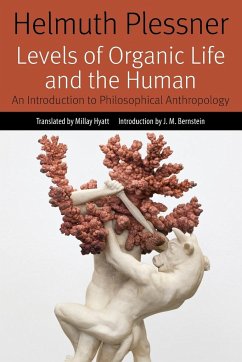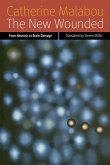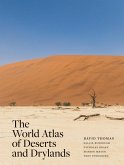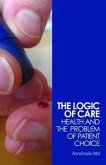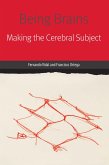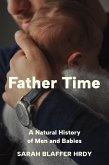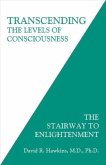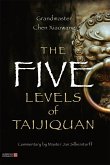- Broschiertes Buch
- Merkliste
- Auf die Merkliste
- Bewerten Bewerten
- Teilen
- Produkt teilen
- Produkterinnerung
- Produkterinnerung
A modern classic, this powerful and sophisticated account of embodiment was first published in German in 1928 and now appears in English for the first time. With reference simultaneously to science, social theory, and philosophy, Plessner shows how life can be seen on its own terms to establish its own boundaries. Plessner's account of how the human establishes itself in relation to the nonhuman will invigorate a range of current conversations around the animal, posthumanism, the material turn, and the biology and sociology of cognition.
Andere Kunden interessierten sich auch für
![The New Wounded The New Wounded]() Catherine MalabouThe New Wounded47,99 €
Catherine MalabouThe New Wounded47,99 €![The World Atlas of Deserts and Drylands The World Atlas of Deserts and Drylands]() David ThomasThe World Atlas of Deserts and Drylands52,99 €
David ThomasThe World Atlas of Deserts and Drylands52,99 €![The Logic of Care The Logic of Care]() Annemarie MolThe Logic of Care44,99 €
Annemarie MolThe Logic of Care44,99 €![Being Brains: Making the Cerebral Subject Being Brains: Making the Cerebral Subject]() Fernando VidalBeing Brains: Making the Cerebral Subject78,99 €
Fernando VidalBeing Brains: Making the Cerebral Subject78,99 €![Father Time Father Time]() Sarah Blaffer HrdyFather Time27,99 €
Sarah Blaffer HrdyFather Time27,99 €![Transcending the Levels of Consciousness Transcending the Levels of Consciousness]() David R. HawkinsTranscending the Levels of Consciousness19,99 €
David R. HawkinsTranscending the Levels of Consciousness19,99 €![The Five Levels of Taijiquan The Five Levels of Taijiquan]() Xiaowang ChenThe Five Levels of Taijiquan38,99 €
Xiaowang ChenThe Five Levels of Taijiquan38,99 €-
-
-
A modern classic, this powerful and sophisticated account of embodiment was first published in German in 1928 and now appears in English for the first time. With reference simultaneously to science, social theory, and philosophy, Plessner shows how life can be seen on its own terms to establish its own boundaries. Plessner's account of how the human establishes itself in relation to the nonhuman will invigorate a range of current conversations around the animal, posthumanism, the material turn, and the biology and sociology of cognition.
Hinweis: Dieser Artikel kann nur an eine deutsche Lieferadresse ausgeliefert werden.
Hinweis: Dieser Artikel kann nur an eine deutsche Lieferadresse ausgeliefert werden.
Produktdetails
- Produktdetails
- Forms of Living
- Verlag: Fordham University Press
- Seitenzahl: 450
- Erscheinungstermin: 2. Juli 2019
- Englisch
- Abmessung: 229mm x 152mm x 27mm
- Gewicht: 642g
- ISBN-13: 9780823283989
- ISBN-10: 0823283984
- Artikelnr.: 53535590
- Herstellerkennzeichnung
- Libri GmbH
- Europaallee 1
- 36244 Bad Hersfeld
- gpsr@libri.de
- Forms of Living
- Verlag: Fordham University Press
- Seitenzahl: 450
- Erscheinungstermin: 2. Juli 2019
- Englisch
- Abmessung: 229mm x 152mm x 27mm
- Gewicht: 642g
- ISBN-13: 9780823283989
- ISBN-10: 0823283984
- Artikelnr.: 53535590
- Herstellerkennzeichnung
- Libri GmbH
- Europaallee 1
- 36244 Bad Hersfeld
- gpsr@libri.de
Helmuth Plessner (Author) Helmuth Plessner (1892-1985) was a German philosopher and sociologist. From 1953-59, he was president of the German Sociological Association. Three of his many books have appeared in English, Political Anthropology (Northwestern, 2018), The Limits of Community (Humanity Books, 1999) and Laughing and Crying (Northwestern, 1970). J. M. Bernstein (Introducer) J. M. Bernstein is University Distinguished Professor in Philosophy at The New School for Social Research in New York City. Millay Hyatt (Translator) Millay Hyatt is a writer and translator based in Berlin. Her dissertation, "No-Where and Now-Here: Utopia and Politics from Hegel to Deleuze," received the University of Southern California's doctoral research prize.
Foreword from the Helmuth Plessner Society vii Translator's Preface and Acknowledgments ix Preface to the First Edition (1928) xv Preface to the Second Edition (1965) xix Introduction xxxvii J. M. Bernstein 1. Aim and Scope of the Study 1 The Development of Intuitionist Lebensphilosophie in Opposition to Experience, 3
Lebensphilosophie and the Theory of the Humanities, 11
Working Plan for the Foundation of a Philosophy of the Human, 22 2. The Cartesian Objection and the Nature of the Problem 34 Extension vs. Interiority and the Problem of Appearance, 34
Appearance as Originating in Interiority, 38
The Prior Givenness of Interiority and the Forward Displacement of Myself: The Proposition of Immanence 41
Extension as Outer World; Interiority as Inner World, 46
The Proposition of Representation and the Element of Sensation, 51
The Inaccessibility of Other I's according to the Principle of Sensualism, 55
The Need for a Revision of the Cartesian Dichotomy in the Interest of a Science of Life, 58
A Methodological Reformulation of the Opening Question, 64 3. The Thesis 75 The Question, 75
The Dual Aspect in the Appearance of Ordinary Perceptual Things, 76
Against the Misinterpretation of This Analysis: A Closer Focus on the Subject Matter, 81
The Dual Aspect of Living Perceptual Things: Köhler contra Driesch, 84
How Is Dual Aspectivity Possible? The Nature of the Boundary, 93
The Task of a Theory of the Essential Characteristics of the Organic, 99
Definitions of Life, 104
Nature and Object of a Theory of the Essential Characteristics of the Organic, 110 4. The Modes of Being of Vitality 115 Essential Characteristics Indicating Vitality, 115
The Positionality of Living Being and Its Spacelikeness, 118
Living Being as Process and Type; the Dynamic Character of the Living Form; the Individuality of the Living Thing, 123
Living Process as Development, 129
The Curve of Development: Aging and Death, 137
The Individual Living Thing as a System, 144
The Self-Regulation of the Individual Living Thing and the Harmonious Equipotentiality of Its Parts, 149
Individual Living Things as Organized: The Dual Meaning of Organs, 154
The Temporality of Living Being, 159
The Positional Union of Space and Time and the Natural Place, 168 5. The Organizational Modes of Living Being: Plants and Animals 172 The Circle of Life, 172
Assimilation-Dissimilation, 182
Adaptedness and Adaptation, 186
Reproduction, Heredity, Selection, 196
The Open Form of Organization of the Plant, 202
The Closed Form of Organization of the Animal, 209 6. The Sphere of the Animal 219 The Positionality of the Closed Form: Centrality and Frontality, 219
The Coordination of Stimulus and Response in the Case of an Inoperative Subject (Decentralized Type of Organization), 227
The Coordination of Stimulus and Response by a Subject (Centralized Type of Organization), 231
The Animal's Surrounding Field Organized into Complex Qualities and Things, 242
Intelligence, 252
Memory, 257
Memory as the Unity of Residue and Anticipation, 262 7. The Sphere of the Human 267 The Positionality of the Excentric Form: "I" and Personhood, 267
Outer World, Inner World, Shared World, 272
The Fundamental Laws of Anthropology: The Law of Natural Artificiality, 287
The Law of Mediated Immediacy: Immanence and Expressivity, 298
The Law of the Utopian Standpoint: Nullity and Transcendence, 316 Appendix 323 Glossary 337 Notes 345 Index 359
Lebensphilosophie and the Theory of the Humanities, 11
Working Plan for the Foundation of a Philosophy of the Human, 22 2. The Cartesian Objection and the Nature of the Problem 34 Extension vs. Interiority and the Problem of Appearance, 34
Appearance as Originating in Interiority, 38
The Prior Givenness of Interiority and the Forward Displacement of Myself: The Proposition of Immanence 41
Extension as Outer World; Interiority as Inner World, 46
The Proposition of Representation and the Element of Sensation, 51
The Inaccessibility of Other I's according to the Principle of Sensualism, 55
The Need for a Revision of the Cartesian Dichotomy in the Interest of a Science of Life, 58
A Methodological Reformulation of the Opening Question, 64 3. The Thesis 75 The Question, 75
The Dual Aspect in the Appearance of Ordinary Perceptual Things, 76
Against the Misinterpretation of This Analysis: A Closer Focus on the Subject Matter, 81
The Dual Aspect of Living Perceptual Things: Köhler contra Driesch, 84
How Is Dual Aspectivity Possible? The Nature of the Boundary, 93
The Task of a Theory of the Essential Characteristics of the Organic, 99
Definitions of Life, 104
Nature and Object of a Theory of the Essential Characteristics of the Organic, 110 4. The Modes of Being of Vitality 115 Essential Characteristics Indicating Vitality, 115
The Positionality of Living Being and Its Spacelikeness, 118
Living Being as Process and Type; the Dynamic Character of the Living Form; the Individuality of the Living Thing, 123
Living Process as Development, 129
The Curve of Development: Aging and Death, 137
The Individual Living Thing as a System, 144
The Self-Regulation of the Individual Living Thing and the Harmonious Equipotentiality of Its Parts, 149
Individual Living Things as Organized: The Dual Meaning of Organs, 154
The Temporality of Living Being, 159
The Positional Union of Space and Time and the Natural Place, 168 5. The Organizational Modes of Living Being: Plants and Animals 172 The Circle of Life, 172
Assimilation-Dissimilation, 182
Adaptedness and Adaptation, 186
Reproduction, Heredity, Selection, 196
The Open Form of Organization of the Plant, 202
The Closed Form of Organization of the Animal, 209 6. The Sphere of the Animal 219 The Positionality of the Closed Form: Centrality and Frontality, 219
The Coordination of Stimulus and Response in the Case of an Inoperative Subject (Decentralized Type of Organization), 227
The Coordination of Stimulus and Response by a Subject (Centralized Type of Organization), 231
The Animal's Surrounding Field Organized into Complex Qualities and Things, 242
Intelligence, 252
Memory, 257
Memory as the Unity of Residue and Anticipation, 262 7. The Sphere of the Human 267 The Positionality of the Excentric Form: "I" and Personhood, 267
Outer World, Inner World, Shared World, 272
The Fundamental Laws of Anthropology: The Law of Natural Artificiality, 287
The Law of Mediated Immediacy: Immanence and Expressivity, 298
The Law of the Utopian Standpoint: Nullity and Transcendence, 316 Appendix 323 Glossary 337 Notes 345 Index 359
Foreword from the Helmuth Plessner Society vii Translator's Preface and Acknowledgments ix Preface to the First Edition (1928) xv Preface to the Second Edition (1965) xix Introduction xxxvii J. M. Bernstein 1. Aim and Scope of the Study 1 The Development of Intuitionist Lebensphilosophie in Opposition to Experience, 3
Lebensphilosophie and the Theory of the Humanities, 11
Working Plan for the Foundation of a Philosophy of the Human, 22 2. The Cartesian Objection and the Nature of the Problem 34 Extension vs. Interiority and the Problem of Appearance, 34
Appearance as Originating in Interiority, 38
The Prior Givenness of Interiority and the Forward Displacement of Myself: The Proposition of Immanence 41
Extension as Outer World; Interiority as Inner World, 46
The Proposition of Representation and the Element of Sensation, 51
The Inaccessibility of Other I's according to the Principle of Sensualism, 55
The Need for a Revision of the Cartesian Dichotomy in the Interest of a Science of Life, 58
A Methodological Reformulation of the Opening Question, 64 3. The Thesis 75 The Question, 75
The Dual Aspect in the Appearance of Ordinary Perceptual Things, 76
Against the Misinterpretation of This Analysis: A Closer Focus on the Subject Matter, 81
The Dual Aspect of Living Perceptual Things: Köhler contra Driesch, 84
How Is Dual Aspectivity Possible? The Nature of the Boundary, 93
The Task of a Theory of the Essential Characteristics of the Organic, 99
Definitions of Life, 104
Nature and Object of a Theory of the Essential Characteristics of the Organic, 110 4. The Modes of Being of Vitality 115 Essential Characteristics Indicating Vitality, 115
The Positionality of Living Being and Its Spacelikeness, 118
Living Being as Process and Type; the Dynamic Character of the Living Form; the Individuality of the Living Thing, 123
Living Process as Development, 129
The Curve of Development: Aging and Death, 137
The Individual Living Thing as a System, 144
The Self-Regulation of the Individual Living Thing and the Harmonious Equipotentiality of Its Parts, 149
Individual Living Things as Organized: The Dual Meaning of Organs, 154
The Temporality of Living Being, 159
The Positional Union of Space and Time and the Natural Place, 168 5. The Organizational Modes of Living Being: Plants and Animals 172 The Circle of Life, 172
Assimilation-Dissimilation, 182
Adaptedness and Adaptation, 186
Reproduction, Heredity, Selection, 196
The Open Form of Organization of the Plant, 202
The Closed Form of Organization of the Animal, 209 6. The Sphere of the Animal 219 The Positionality of the Closed Form: Centrality and Frontality, 219
The Coordination of Stimulus and Response in the Case of an Inoperative Subject (Decentralized Type of Organization), 227
The Coordination of Stimulus and Response by a Subject (Centralized Type of Organization), 231
The Animal's Surrounding Field Organized into Complex Qualities and Things, 242
Intelligence, 252
Memory, 257
Memory as the Unity of Residue and Anticipation, 262 7. The Sphere of the Human 267 The Positionality of the Excentric Form: "I" and Personhood, 267
Outer World, Inner World, Shared World, 272
The Fundamental Laws of Anthropology: The Law of Natural Artificiality, 287
The Law of Mediated Immediacy: Immanence and Expressivity, 298
The Law of the Utopian Standpoint: Nullity and Transcendence, 316 Appendix 323 Glossary 337 Notes 345 Index 359
Lebensphilosophie and the Theory of the Humanities, 11
Working Plan for the Foundation of a Philosophy of the Human, 22 2. The Cartesian Objection and the Nature of the Problem 34 Extension vs. Interiority and the Problem of Appearance, 34
Appearance as Originating in Interiority, 38
The Prior Givenness of Interiority and the Forward Displacement of Myself: The Proposition of Immanence 41
Extension as Outer World; Interiority as Inner World, 46
The Proposition of Representation and the Element of Sensation, 51
The Inaccessibility of Other I's according to the Principle of Sensualism, 55
The Need for a Revision of the Cartesian Dichotomy in the Interest of a Science of Life, 58
A Methodological Reformulation of the Opening Question, 64 3. The Thesis 75 The Question, 75
The Dual Aspect in the Appearance of Ordinary Perceptual Things, 76
Against the Misinterpretation of This Analysis: A Closer Focus on the Subject Matter, 81
The Dual Aspect of Living Perceptual Things: Köhler contra Driesch, 84
How Is Dual Aspectivity Possible? The Nature of the Boundary, 93
The Task of a Theory of the Essential Characteristics of the Organic, 99
Definitions of Life, 104
Nature and Object of a Theory of the Essential Characteristics of the Organic, 110 4. The Modes of Being of Vitality 115 Essential Characteristics Indicating Vitality, 115
The Positionality of Living Being and Its Spacelikeness, 118
Living Being as Process and Type; the Dynamic Character of the Living Form; the Individuality of the Living Thing, 123
Living Process as Development, 129
The Curve of Development: Aging and Death, 137
The Individual Living Thing as a System, 144
The Self-Regulation of the Individual Living Thing and the Harmonious Equipotentiality of Its Parts, 149
Individual Living Things as Organized: The Dual Meaning of Organs, 154
The Temporality of Living Being, 159
The Positional Union of Space and Time and the Natural Place, 168 5. The Organizational Modes of Living Being: Plants and Animals 172 The Circle of Life, 172
Assimilation-Dissimilation, 182
Adaptedness and Adaptation, 186
Reproduction, Heredity, Selection, 196
The Open Form of Organization of the Plant, 202
The Closed Form of Organization of the Animal, 209 6. The Sphere of the Animal 219 The Positionality of the Closed Form: Centrality and Frontality, 219
The Coordination of Stimulus and Response in the Case of an Inoperative Subject (Decentralized Type of Organization), 227
The Coordination of Stimulus and Response by a Subject (Centralized Type of Organization), 231
The Animal's Surrounding Field Organized into Complex Qualities and Things, 242
Intelligence, 252
Memory, 257
Memory as the Unity of Residue and Anticipation, 262 7. The Sphere of the Human 267 The Positionality of the Excentric Form: "I" and Personhood, 267
Outer World, Inner World, Shared World, 272
The Fundamental Laws of Anthropology: The Law of Natural Artificiality, 287
The Law of Mediated Immediacy: Immanence and Expressivity, 298
The Law of the Utopian Standpoint: Nullity and Transcendence, 316 Appendix 323 Glossary 337 Notes 345 Index 359

